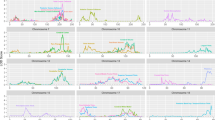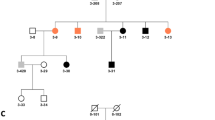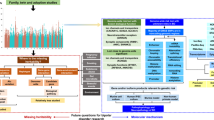Abstract
Linkage studies suggest that chromosome 22q12–13 may contain one or more shared susceptibility genes for schizophrenia (SZ) and bipolar affective disorder (BPD). In a Faeroese sample, we previously reported association between microsatellite markers located at 22q13.31-qtel and both disorders. The present study reports an association analysis across five genes (including 14 single nucleotide and two microsatellite polymorphisms) in this interval using a case–control sample of 162 BPD, 103 SZ patients and 200 controls. The bromodomain-containing 1 gene (BRD1), which encodes a putative regulator of transcription showed association with both disorders with minimal P-values of 0.0046 and 0.00001 for single marker and overall haplotype analysis, respectively. A specific BRD1 2-marker ‘risk’ haplotype showed a frequency of ∼10% in the combined case group versus ∼1% in controls (P-value 2.8 × 10−7). Expression analysis of BRD1 mRNA revealed widespread expression in mammalian brain tissue, which was substantiated by immunohistochemical detection of BRD1 protein in the nucleus, perikaryal cytosol and proximal dendrites of the neurons in the adult rat, rabbit and human CNS. Quantitative mRNA analysis in developing fetal pig brain revealed spatiotemporal differences with high expression at early embryonic stages, with intense nuclear and cytosolar immunohistochemical staining of the neuroepithelial layer and early neuroblasts, whilst more mature neurons at later embryonic stages had less nuclear staining. The results implicate BRD1 with SZ and BPD susceptibility and provide evidence that suggests a role for BRD1 in neurodevelopment.
This is a preview of subscription content, access via your institution
Access options
Subscribe to this journal
Receive 12 print issues and online access
$259.00 per year
only $21.58 per issue
Buy this article
- Purchase on Springer Link
- Instant access to full article PDF
Prices may be subject to local taxes which are calculated during checkout





Similar content being viewed by others
References
McGuffin P, Owen MJ, Farmer AE . Genetic basis of schizophrenia. Lancet 1995; 346: 678–682.
Potash JB, DePaulo Jr JR . Searching high and low: a review of the genetics of bipolar disorder. Bipolar Disord 2000; 2: 8–26.
Berrettini W . Evidence for shared susceptibility in bipolar disorder and schizophrenia. Am J Med Genet C Semin Med Genet 2003; 123: 59–64.
Als TD, Dahl HA, Flint TJ, Wang AG, Vang M, Mors O et al. Possible evidence for a common risk locus for bipolar affective disorder and schizophrenia on chromosome 4p16 in patients from the Faroe Islands. Mol Psychiatry 2004; 9: 93–98.
Asherson P, Mant R, Williams N, Cardno A, Jones L, Murphy K et al. A study of chromosome 4p markers and dopamine D5 receptor gene in schizophrenia and bipolar disorder. Mol Psychiatry 1998; 3: 310–320.
Blackwood DH, He L, Morris SW, McLean A, Whitton C, Thomson M et al. A locus for bipolar affective disorder on chromosome 4p. Nat Genet 1996; 12: 427–430.
Wildenauer DB, Schwab SG, Maier W, Detera-Wadleigh SD . Do schizophrenia and affective disorder share susceptibility genes? Schizophr Res 1999; 39: 107–111.
Schwab SG, Wildenauer DB . Chromosome 22 workshop report. Am J Med Genet 1999; 88: 276–278.
Badner JA, Gershon ES . Meta-analysis of whole-genome linkage scans of bipolar disorder and schizophrenia. Mol Psychiatry 2002; 7: 405–411.
Lewis CM, Levinson DF, Wise LH, DeLisi LE, Straub RE, Hovatta I et al. Genome scan meta-analysis of schizophrenia and bipolar disorder, part II: Schizophrenia. Am J Hum Genet 2003; 73: 34–48.
Coon H, Jensen S, Holik J, Hoff M, Myles-Worsley M, Reimherr F et al. Genomic scan for genes predisposing to schizophrenia. Am J Med Genet 1994; 54: 59–71.
Mowry BJ, Holmans PA, Pulver AE, Gejman PV, Riley B, Williams NM et al. Multicenter linkage study of schizophrenia loci on chromosome 22q. Mol Psychiatry 2004; 9: 784–795.
Takahashi S, Faraone SV, Lasky-Su J, Tsuang MT . Genome-wide scan of homogeneous subtypes of NIMH genetics initiative schizophrenia families. Psychiatry Res 2005; 133: 111–122.
Stober G, Saar K, Ruschendorf F, Meyer J, Nurnberg G, Jatzke S et al. Splitting schizophrenia: periodic catatonia-susceptibility locus on chromosome 15q15. Am J Hum Genet 2000; 67: 1201–1207.
Kelsoe JR, Spence MA, Loetscher E, Foguet M, Sadovnick AD, Remick RA et al. A genome survey indicates a possible susceptibility locus for bipolar disorder on chromosome 22. Proc Natl Acad Sci USA 2001; 98: 585–590.
Jorgensen TH, Borglum AD, Mors O, Wang AG, Pinaud M, Flint TJ et al. Search for common haplotypes on chromosome 22q in patients with schizophrenia or bipolar disorder from the Faroe Islands. Am J Med Genet 2002; 114: 245–252.
Borglum AD, Hampson M, Kjeldsen TE, Muir W, Murray V, Ewald H et al. Dopa decarboxylase genotypes may influence age at onset of schizophrenia. Mol Psychiatry 2001; 6: 712–717.
Borglum AD, Kirov G, Craddock N, Mors O, Muir W, Murray V et al. Possible parent-of-origin effect of Dopa decarboxylase in susceptibility to bipolar affective disorder. Am J Med Genet B Neuropsychiatr Genet 2003; 117: 18–22.
Zaykin DV, Westfall PH, Young SS, Karnoub MA, Wagner MJ, Ehm MG . Testing association of statistically inferred haplotypes with discrete and continuous traits in samples of unrelated individuals. Hum Hered 2002; 53: 79–91.
Excoffier L, Slatkin M . Maximum-likelihood estimation of molecular haplotype frequencies in a diploid population. Mol Biol Evol 1995; 12: 921–927.
Quandt K, Frech K, Karas H, Wingender E, Werner T . MatInd and MatInspector: new fast and versatile tools for detection of consensus matches in nucleotide sequence data. Nucleic Acids Res 1995; 23: 4878–4884.
Werner T . Computer-assisted analysis of transcription control regions. Matinspector and other programs. Methods Mol Biol 2000; 132: 337–349.
Cartegni L, Wang J, Zhu Z, Zhang MQ, Krainer AR . ESEfinder: A web resource to identify exonic splicing enhancers. Nucleic Acids Res 2003; 31: 3568–3571.
Fairbrother WG, Yeh RF, Sharp PA, Burge CB . Predictive identification of exonic splicing enhancers in human genes. Science 2002; 297: 1007–1013.
Wang Z, Rolish ME, Yeo G, Tung V, Mawson M, Burge CB . Systematic identification and analysis of exonic splicing silencers. Cell 2004; 119: 831–845.
Yeo G, Burge CB . Maximum entropy modeling of short sequence motifs with applications to RNA splicing signals. J Comput Biol 2004; 11: 377–394.
Reese MG, Eeckman FH, Kulp D, Haussler D . Improved splice site detection in Genie. J Comput Biol 1997; 4: 311–323.
Jensen TG, Andresen BS, Bross P, Jensen UB, Holme E, Kolvraa S et al. Expression of wild-type and mutant medium-chain acyl-CoA dehydrogenase (MCAD) cDNA in eucaryotic cells. Biochim Biophys Acta 1992; 1180: 65–72.
Bjarkam CR, Pedersen M, Sorensen JC . New strategies for embedding, orientation and sectioning of small brain specimens enable direct correlation to MR-images, brain atlases, or use of unbiased stereology. J Neurosci Methods 2001; 108: 153–159.
McCullagh P, Chaplin T, Meerabux J, Grenzelias D, Lillington D, Poulsom R et al. The cloning, mapping and expression of a novel gene, BRL, related to the AF10 leukaemia gene. Oncogene 1999; 18: 7442–7452.
Livak KJ, Schmittgen TD . Analysis of relative gene expression data using real-time quantitative PCR and the 2(−Delta Delta C(T)) Method. Methods 2001; 25: 402–408.
Schmitz G, Heimerl S, Langmann T . Zinc finger protein ZNF202 structure and function in transcriptional control of HDL metabolism. Curr Opin Lipidol 2004; 15: 199–208.
Ishibashi M . Molecular mechanisms for morphogenesis of the central nervous system in mammals. Anat Sci Int 2004; 79: 226–234.
Meyer J, Huberth A, Ortega G, Syagailo YV, Jatzke S, Mossner R et al. A missense mutation in a novel gene encoding a putative cation channel is associated with catatonic schizophrenia in a large pedigree. Mol Psychiatry 2001; 6: 302–306.
Devaney JM, Donarum EA, Brown KM, Meyer J, Stober G, Lesch KP et al. No missense mutation of WKL1 in a subgroup of probands with schizophrenia. Mol Psychiatry 2002; 7: 419–423.
Kaganovich M, Peretz A, Ritsner M, Bening Abu-Shach U, Attali B, Navon R . Is the WKL1 gene associated with schizophrenia? Am J Med Genet B Neuropsychiatr Genet 2004; 125: 31–37.
Rubie C, Lichtner P, Gartner J, Siekiera M, Uziel G, Kohlmann B et al. Sequence diversity of KIAA0027/MLC1: are megalencephalic leukoencephalopathy and schizophrenia allelic disorders? Hum Mutat 2003; 21: 45–52.
Verma R, Mukerji M, Grover D, B-Rao C, Das SK, Kubendran S et al. MLC1 gene is associated with schizophrenia and bipolar disorder in Southern India. Biol Psychiatry 2005; 58: 16–22.
Castella P, Wagner JA, Caudy M . Regulation of hippocampal neuronal differentiation by the basic helix-loop-helix transcription factors HES-1 and MASH-1. J Neurosci Res 1999; 56: 229–240.
Lukasik SM, Cierpicki T, Borloz M, Grembecka J, Everett A, Bushweller JH . High resolution structure of the HDGF PWWP domain: a potential DNA binding domain. Protein Sci 2006; 15: 314–323.
Ladurner AG, Inouye C, Jain R, Tjian R . Bromodomains mediate an acetyl-histone encoded antisilencing function at heterochromatin boundaries. Mol Cell 2003; 11: 365–376.
Ragvin A, Valvatne H, Erdal S, Arskog V, Tufteland KR, Breen K et al. Nucleosome binding by the bromodomain and PHD finger of the transcriptional cofactor p300. J Mol Biol 2004; 337: 773–788.
Rapoport JL, Addington AM, Frangou S, Psych MR . The neurodevelopmental model of schizophrenia: update 2005. Mol Psychiatry 2005; 10: 434–449.
Strakowski SM, Delbello MP, Adler CM . The functional neuroanatomy of bipolar disorder: a review of neuroimaging findings. Mol Psychiatry 2005; 10: 105–116.
Pilowsky LS, Kerwin RW, Murray RM . Schizophrenia: a neurodevelopmental perspective. Neuropsychopharmacology 1993; 9: 83–91.
Waddington JL, Torrey EF, Crow TJ, Hirsch SR . Schizophrenia, neurodevelopment, and disease. The Fifth Biannual Winter Workshop on Schizophrenia, Badgastein, Austria, January 28 to February 3, 1990. Arch Gen Psychiatry 1991; 48: 271–273.
Weinberger DR . Implications of normal brain development for the pathogenesis of schizophrenia. Arch Gen Psychiatry 1987; 44: 660–669.
Corfas G, Roy K, Buxbaum JD . Neuregulin 1-erbB signaling and the molecular/cellular basis of schizophrenia. Nat Neurosci 2004; 7: 575–580.
Stefansson H, Sigurdsson E, Steinthorsdottir V, Bjornsdottir S, Sigmundsson T, Ghosh S et al. Neuregulin 1 and susceptibility to schizophrenia. Am J Hum Genet 2002; 71: 877–892.
Stefansson H, Steinthorsdottir V, Thorgeirsson TE, Gulcher JR, Stefansson K . Neuregulin 1 and schizophrenia. Ann Med 2004; 36: 62–71.
Callicott JH, Straub RE, Pezawas L, Egan MF, Mattay VS, Hariri AR et al. Variation in DISC1 affects hippocampal structure and function and increases risk for schizophrenia. Proc Natl Acad Sci USA 2005; 102: 8627–8632.
Kamiya A, Kubo K, Tomoda T, Takaki M, Youn R, Ozeki Y et al. A schizophrenia-associated mutation of DISC1 perturbs cerebral cortex development. Nat Cell Biol 2005; 7: 1167–1178.
Millar JK, Christie S, Porteous DJ . Yeast two-hybrid screens implicate DISC1 in brain development and function. Biochem Biophys Res Commun 2003; 311: 1019–1025.
Millar JK, Wilson-Annan JC, Anderson S, Christie S, Taylor MS, Semple CA et al. Disruption of two novel genes by a translocation co-segregating with schizophrenia. Hum Mol Genet 2000; 9: 1415–1423.
Craddock N, O’Donovan MC, Owen MJ . The genetics of schizophrenia and bipolar disorder: dissecting psychosis. J Med Genet 2005; 42: 193–204.
Craddock N, O’Donovan MC, Owen MJ . Genes for schizophrenia and bipolar disorder?. Implications for psychiatric nosology. Schizophr Bull 2006; 32: 9–16.
Acknowledgements
The authors acknowledge with gratitude the skillful assistance of Ms HG Binderup, Mr C Westberg, Ms D Jensen, Ms L Munkøe, and Ms K Jensen.
The Danish Medical Research Council, The Faculty of Health Sciences, University of Aarhus, The Desirée and Niels Yde's Foundation, the Psychiatric Research Foundation, The Aarhus University Research Foundation, The Alice Brenaa Foundation, The Foundation for the Advancement of Medical Science, The Lily Benthine Lund Foundation, The Medical Society of Aarhus County, The Research Foundation of the Danish Medical Association, Pulje til styrkelse af Psykiatrisk Forskning, The Novo Nordic Foundation, The Aase and Ejnar Danielsen Foundation, The Foundation of Direktør Ib Henriksen, The Foundation of Jacob Madsen and Wife, The Foundation of consultant Dr med E Geert-Jørgensen and Wife, and The Foundation of King Christian the 10th supported the study. The Scottish sample collection was funded by grants from the Scottish Executive, the Medical Research Council and the Wellcome Trust.
Author information
Authors and Affiliations
Corresponding author
Rights and permissions
About this article
Cite this article
Severinsen, J., Bjarkam, C., Kiar-Larsen, S. et al. Evidence implicating BRD1 with brain development and susceptibility to both schizophrenia and bipolar affective disorder. Mol Psychiatry 11, 1126–1138 (2006). https://doi.org/10.1038/sj.mp.4001885
Received:
Revised:
Accepted:
Published:
Issue Date:
DOI: https://doi.org/10.1038/sj.mp.4001885
Keywords
This article is cited by
-
The psychiatric risk gene BRD1 modulates mitochondrial bioenergetics by transcriptional regulation
Translational Psychiatry (2022)
-
DNA methylation epi-signature is associated with two molecularly and phenotypically distinct clinical subtypes of Phelan-McDermid syndrome
Clinical Epigenetics (2021)
-
Inactivation of the Schizophrenia-associated BRD1 gene in Brain Causes Failure-to-thrive, Seizure Susceptibility and Abnormal Histone H3 Acetylation and N-tail Clipping
Molecular Neurobiology (2021)
-
Reduced Brd1 expression leads to reversible depression-like behaviors and gene-expression changes in female mice
Translational Psychiatry (2020)
-
Brain volumetric alterations accompanied with loss of striatal medium-sized spiny neurons and cortical parvalbumin expressing interneurons in Brd1+/− mice
Scientific Reports (2018)



